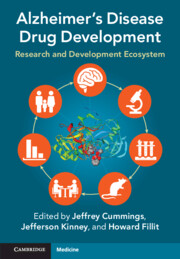Book contents
- Alzheimer’s Disease Drug Development
- Alzheimer’s Disease Drug Development
- Copyright page
- Dedication
- Contents
- Contributors
- Foreword
- Acknowledgments
- Section 1 Advancing Alzheimer’s Disease Therapies in a Collaborative Science Ecosystem
- Section 2 Non-clinical Assessment of Alzheimer’s Disease Candidate Drugs
- 7 Role of Animal Models in Alzheimer’s Disease Drug Development
- 8 Use of Induced Pluripotent Stem Cell-Derived Neuronal Disease Models from Patients with Familial Early-Onset Alzheimer’s Disease in Drug Discovery
- 9 Preclinical Longitudinal In Vivo Biomarker Platform for Alzheimer’s Disease Drug Discovery
- 10 Biobanking and Biomarkers in the Alzheimer’s Disease Drug-Development Ecosystem
- Section 3 Alzheimer’s Disease Clinical Trials
- Section 4 Imaging and Biomarker Development in Alzheimer’s Disease Drug Discovery
- Section 5 Academic Drug-Development Programs
- Section 6 Public–Private Partnerships in Alzheimer’s Disease Drug Development
- Section 7 Funding and Financing Alzheimer’s Disease Drug Development
- Index
- References
7 - Role of Animal Models in Alzheimer’s Disease Drug Development
from Section 2 - Non-clinical Assessment of Alzheimer’s Disease Candidate Drugs
Published online by Cambridge University Press: 03 March 2022
- Alzheimer’s Disease Drug Development
- Alzheimer’s Disease Drug Development
- Copyright page
- Dedication
- Contents
- Contributors
- Foreword
- Acknowledgments
- Section 1 Advancing Alzheimer’s Disease Therapies in a Collaborative Science Ecosystem
- Section 2 Non-clinical Assessment of Alzheimer’s Disease Candidate Drugs
- 7 Role of Animal Models in Alzheimer’s Disease Drug Development
- 8 Use of Induced Pluripotent Stem Cell-Derived Neuronal Disease Models from Patients with Familial Early-Onset Alzheimer’s Disease in Drug Discovery
- 9 Preclinical Longitudinal In Vivo Biomarker Platform for Alzheimer’s Disease Drug Discovery
- 10 Biobanking and Biomarkers in the Alzheimer’s Disease Drug-Development Ecosystem
- Section 3 Alzheimer’s Disease Clinical Trials
- Section 4 Imaging and Biomarker Development in Alzheimer’s Disease Drug Discovery
- Section 5 Academic Drug-Development Programs
- Section 6 Public–Private Partnerships in Alzheimer’s Disease Drug Development
- Section 7 Funding and Financing Alzheimer’s Disease Drug Development
- Index
- References
Summary
Animal model systems play a fundamental role in the development and evaluation of novel treatments for Alzheimer’s disease (AD). The examination of safety and tolerability in animal models is a necessary first step prior to any human clinical trials. Equally important, preclinical testing of novel therapeutics in disease relevant models is required for the determination if a potential therapeutic should advance. There are a number of important considerations in the preclinical workflow that range from selection of the most appropriate animal model related to drug mechanism of action, as well as what AD-relevant measures are to be evaluated to determine if a candidate therapy should advance. In this chapter we highlight the process of preclinical animal model testing for novel therapeutics in AD, as well as detail several of the models utilized and the measures relevant to AD. We also include the emerging approaches to provide better AD animal models (MODEL-AD) as well as emerging approaches to refine the process of identifying new treatments (TREAT-AD).
- Type
- Chapter
- Information
- Alzheimer's Disease Drug DevelopmentResearch and Development Ecosystem, pp. 73 - 94Publisher: Cambridge University PressPrint publication year: 2022

